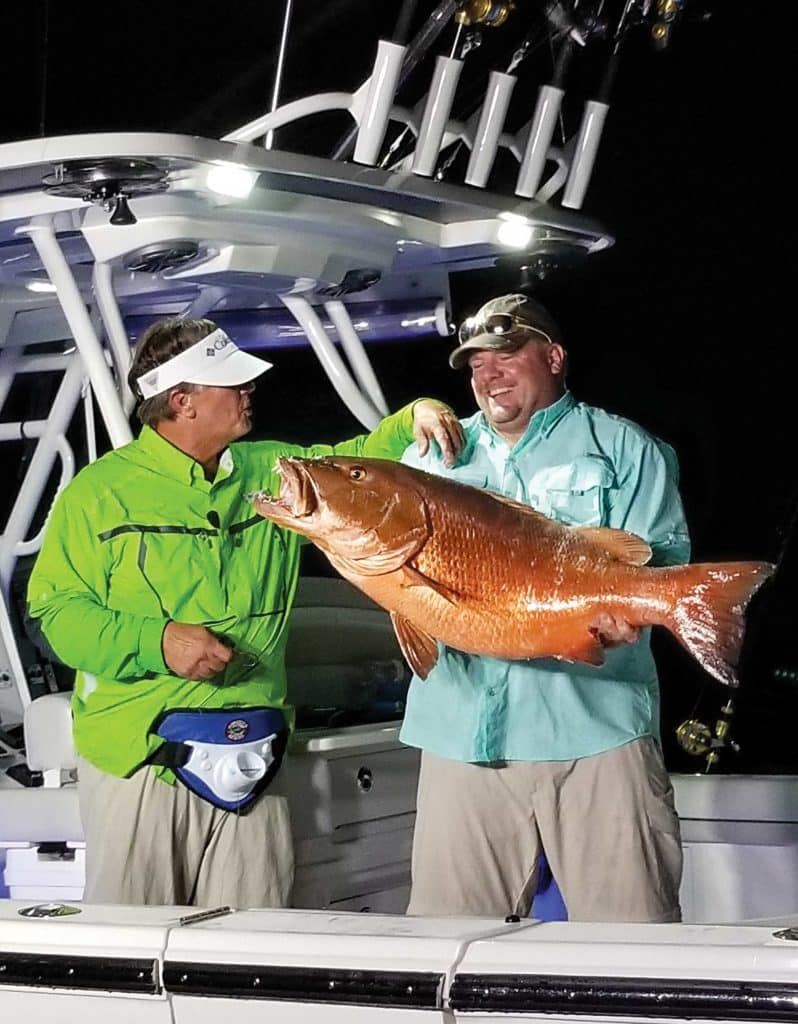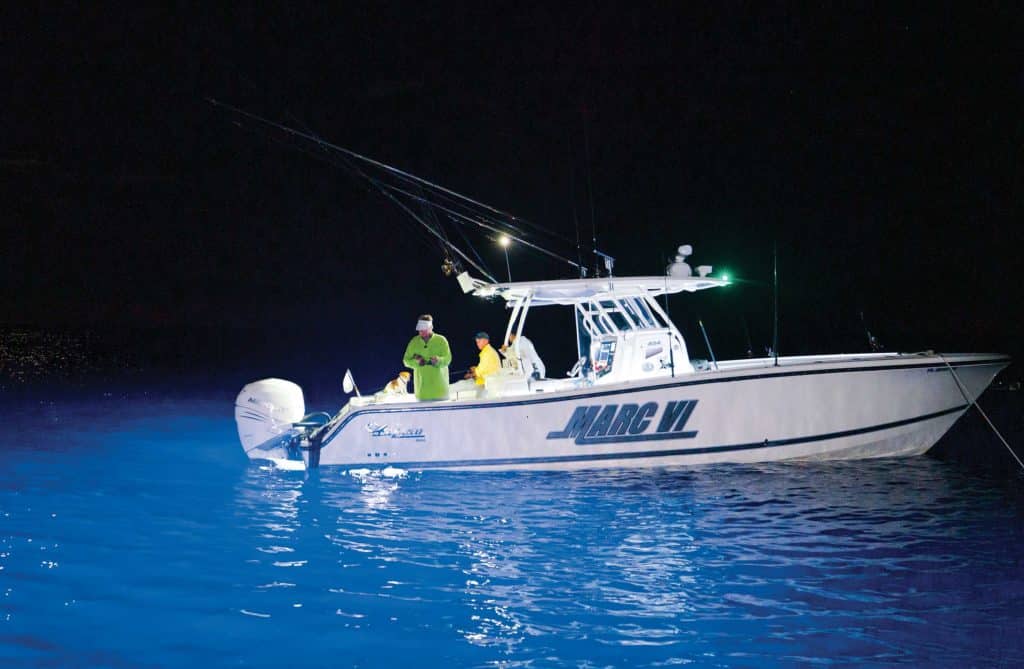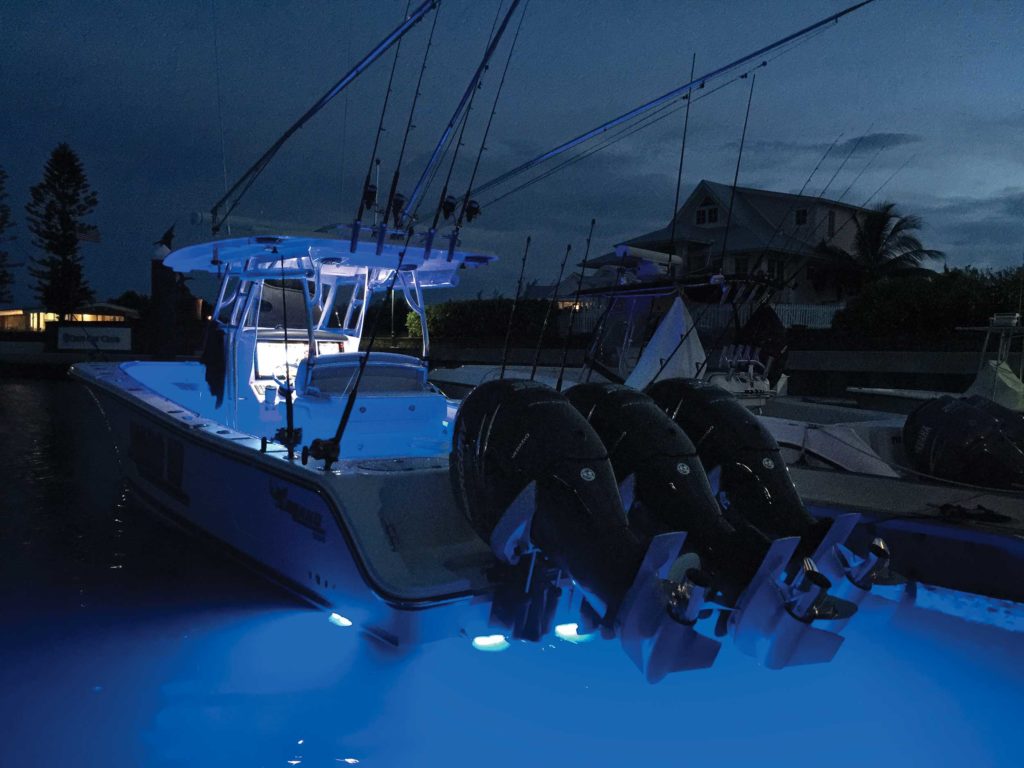
Underwater fishing lights draw forage species and, ultimately, predators into the upper water column and often to the transom. Illumination penetrating a dark ocean draws attention like a neon restaurant sign to hungry motorists. But there’s more to it than simply plug-and-play. There is a science behind it.
Light Show
On a recent night-snapper trip off Fort Myers, Florida, Steve Sewell and I were targeting mangrove snapper 65 miles offshore. The particular wreck we were fishing was touted for holding big yellowtails, as well as an occasional mutton snapper.
We anchored prior to sunset, hung over a chum bag, and activated my Shadow Caster LED transom fishing lights, in Bimini Blue. Darkness brought two surprises. Despite the mass of mangrove snapper marked on the wreck, not one rose to the chum slick. Shortly thereafter, we were visited by pods of porpoises frolicking around the boat, feeding on flying fish and squid drawn by our lights. With these top-tier predators about, mangroves and yellowtails dared not venture near the surface.
Looking to shoot a TV show episode, shutting down the lights was not an option. Fortunately, the slow current allowed Sewell’s jig—tipped with a chunk of cigar minnow—to reach bottom, where it was consumed by a mutton snapper. He repeated the move four times, and scored as many muttons. I adjusted my technique, and joined Sewell in limiting out on muttons.
Why weren’t our muttons intercepted by porpoises? I believe they recognized our lights were responsible for their feast, so as payback (to keep us from shutting off the lights), they left our catch undisturbed.
Voice of Experience
With over five decades of bottomfishing experience, Capt. Bouncer Smith states that some snappers, mangroves in particular, don’t like unnatural light. “When we fished for mangroves at night, we used as little light as possible,” he says. “We’d dim our anchor light and shut off any lights in the boat, and the mangroves chummed up nicely. When I worked on headboats, the deck and bridge lights cast a wide glare on the water, so we’d cast beyond the throw of the light, and let the bait sink. We often bailed the mangroves using this tactic.”
Key West Capt. Mark Schmidt agrees that dark is best for mangroves and yellowtails. “Lights aren’t conducive to night chumming for snappers,” Schmidt says. “The best light comes off the moon. Fishing lights attract bait, which, combined with chumming, brings in sharks, king mackerel and jacks, all major snapper predators. Plus, we fish in shallow water, 60 to 90 feet. With illumination, I believe mangroves and yellowtails lose their sense of security, and they won’t leave the reef. It’s just not comfortable for them.”
Inshore Game
With a lesser threat of predation, striped bass, tarpon, snook, redfish and trout become the hunters, and these species respond well to underwater lights. Many of them are accustomed to feeding along shadow lines from lighted bridges, docks and sea walls.

Underwater fishing lights draw bait to a boat, and that attracts gamefish. They’ll patrol the darkness outside the shadow line, and ambush the aggregated bait drawn to the patch of light. This is a prime scenario for floating back the same live bait they’re dialing in on.
In addition to surface baits, soak one on the bottom, just outside the illumination. Bottom feeders, such as flounder, gather under the commotion. And quite often, trophy-size snook, striped bass, redfish and tarpon prefer feeding along the bottom.
Deep Is Different
Like the Fort Myers mutton snapper blitz, which, incidentally, materialized in 104 feet of water, fishing lights aren’t as intimidating for bottomfish in deeper haunts. I use underwater lights for nighttime cubera snapper off Key Largo, Florida, for two reasons. First, other boats see me and respect my drift; second, it attracts bait, which, combined with the alluring illumination, may stimulate feeding activity from cuberas schooling some 120 to 150 feet below. The cuberas bit well on those outings. The illumination didn’t deter them from eating, and we certainly weren’t crowded by other boats.
Night Bite
Arguably, underwater lights are at their best when night fishing offshore. As Smith reasons: “Out there, you’re in the middle of a desert, and lights pool all life near the boat: squid, flying fish, juvenile gamefish and ultimately the pelagics we’re after. It’s the snowball effect.”
He swears by the Hydro Glow LED portable bait light. “Hanging the light beneath the surface is more effective than transom-mounted lights,” Smith says. “The illumination from transom-mounts is directed straight out or down. Their coverage is limited and subject to the rocking boat; lighting can be a bit erratic and choppy, based on the sea conditions. A submerged light broadcasts steadily in all directions, and creates a shadow line and plenty of ambush points for pelagics.
Manasquan, New Jersey’s Ryan DeGraw turns on his fishing lights 30 to 45 minutes prior to sunset, and shuts them off an hour after daybreak. “It’s essential to our tuna-chunking game,” he says. “Some nights, the tuna bunch up in the light, as long as we fed them. I can’t imagine anyone thinks they can score big out here without lights.”
Color Me a Fish
In the right situation, any color of light attracts fish. Beyond that, color choice becomes a preference based on brightness, penetration, success rate, and to some degree, what looks the coolest. White light, a favorite for lighting up the boat’s immediate surroundings, is the most intense but dissipates the quickest. Red is less intense and also absorbs quickly. The top color for distance penetration is blue, followed by green.

“Traditional green produced best for me,” Smith says. “I recall when blue became the hot color and everyone was saying how it transfers farther into the sea than green. It may have, but after a while, I noticed it wasn’t holding bait and attracting fish as well as the green; so I circled back to what had worked best for us all those years.”
“White is my favorite for tuna chunking,” DeGraw says. “Especially when we’re trying to get squid for bait and hold them around the boat. It also brings bait and tuna right to the transom. Inshore, it’s a different story. For striped bass, green is without a doubt the color. Put out a green light, and forget about it—you’ll catch stripers!”
Daytime Too
Several top-tier sailfishing boats use underwater lights during the day. The illumination beaming through the sea is just one more attraction, which along with the boat sound, prop wash and bait spread, combines to get the attention of gamefish and encourages them to rise for a closer inspection. The LEDs draw little power, so there’s no harm in leaving them on all day. I often light up when trolling offshore, or when drifting and live-baiting for sailfish, blackfin tuna, kingfish and wahoo.
With increasingly warmer water temperatures in summer and fall, more anglers are chilling out by fishing at night when water temps cool, often prompting an uptick in feeding activity, particularly of bottomfish.
Underwater fishing lights are indeed advantageous. Determine how they apply to your environments, and your boat could be the one shining brightly when it’s time to offload the catch.
Gear Up:
Expand your boat’s lighting scheme with one of these quality suppliers:
Shadow-Caster Marine LEDs, shadow-caster.com
Hydro Glow, hydroglow.com
Aqua LED Lighting, aqualuma.com
Lumishore, lumishore.com









